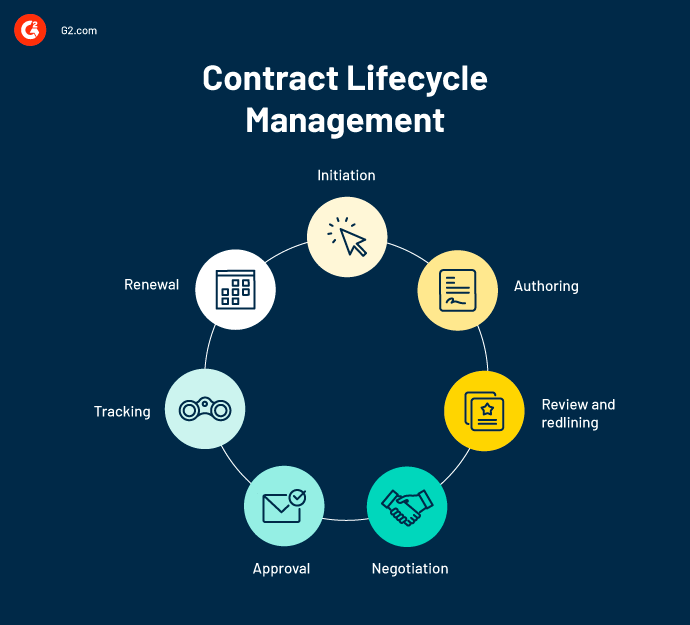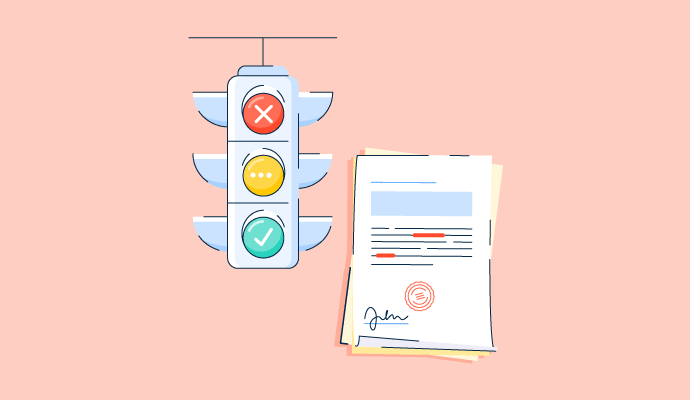Imagine a world where you could snap your fingers and create contracts.
Unfortunately, we don't live in that world (but hey, we can dream!).
Contracts are everywhere in our daily lives. From employment and rental agreements to business contracts, they are vital in establishing clear terms and ensuring everyone knows what they're getting into. But let's face it, managing contracts can be as confusing as unraveling a complex puzzle.
That's where enterprise legal management (ELM) software swoops in to save the day! Organizations can enhance efficiency in creating and managing contracts by automating processes and reclaiming valuable time that would otherwise be spent on time-consuming tasks.
What is contract lifecycle management?
Contract lifecycle management is the process of effectively managing contracts from creation to execution. It involves analyzing performance, ensuring compliance, and mitigating risks for positive operational and financial outcomes.
If you're a business owner, manager, or anyone dealing with contracts (and let's face it, that's most of us), then this article is a must-read. We'll delve into understanding contract lifecycle management and share the best practices to improve efficiency, reduce risks, and increase transparency.
Importance of contract lifecycle management
When two companies enter into doing business together, a contract outlines the mutually agreed-upon terms that govern how companies will fulfill their respective responsibilities. Well-documented agreements executed efficiently reduce costs, streamline processes, and encourage proper vendor management.
Effective contract lifecycle management allows businesses to derive maximum value from their agreements while ensuring compliance with regulations. It helps set standardized and collaborative processes that encourage consistency among stakeholders. With it, businesses can strive for a 'no surprises' approach, where stakeholders know their responsibilities and deadlines.
Contract lifecycle management also acts as a valuable resource in decision-making, dispute resolution, mitigating risks, and safeguarding the interests of both parties. It increases the likelihood of achieving desired outcomes in negotiations while strengthening the overall position of the business.
Contract lifecycle management is critical for businesses as it directly influences agreement outcomes. Poor management of contracts can significantly increase the risk of legal liabilities, undermine the financial health of a business, and negatively impact the reputation of the parties involved.
¿Quieres aprender más sobre Software de Gestión Legal Empresarial (ELM)? Explora los productos de Gestión Legal Empresarial (ELM).
Contract lifecycle management (CLM) process
Contract lifecycle management involves multiple stages covering the entire process from start to finish. It comprises all the tasks involved in contract formation, finalization, formalities, and ongoing management and maintenance of contracts.

Here's a detailed view of each of the stages and steps involved in the process:
Contract initiation
This stage comes before contract administration and marks the beginning of the process. Here, the need for a contract between two parties is identified, and the agreement's scope, objectives, and requirements are discussed.
Contract authoring
The contract is drafted based on the terms and conditions defined by each party involved. The contract drafting stage requires attention to detail as the aim is to reflect the intentions, rights, and obligations of both parties in the contract.
Tip: Implementing contract lifecycle management software can streamline the agreement's creation process by providing templates, standardized clauses, and opportunities for version control.
Contract review and redlining
After the initial draft is created, the contract undergoes a collaborative review involving various internal departments such as business operations, finance, and legal. The goal is to gather input and expertise to ensure the agreement aligns with business requirements and meets legal standards. Poorly phrased contracts can lead to financial losses for organizations, often due to overlooked technicalities.
Tip: To ensure successful contract lifecycle management, involving a legal department or lawyer in contract discussions is advisable, as the precise wording of contracts plays a crucial role.
Contract negotiation
In this stage, the parties involved discuss any differences in duration, price, and terms and conditions. Effective communication, flexibility, and compromise are essential for successful negotiation. This stage may involve multiple revisions to achieve a comprehensive and mutually beneficial contract.
Tip: Using a content management system to identify and resolve discrepancies between different contract versions can save time and prove beneficial during this stage.
Contract approval
Once the negotiation phase is completed, the contract moves to the approval stage. This step can be complex, particularly in large organizations with multiple stakeholders who need to review and provide their consent.
Implementing end-to-end automated workflows can keep decisions moving and help avoid any bottlenecks. Once all parties have approved the contract, it is signed to make it legally binding. This can be done manually or using an electronic signature.
Tip: E-signature software can expedite the signature process. Check out the best e-sign apps to enhance security and reduce paperwork.
Contract tracking
The job does not end with the signing. Contracts require ongoing management to ensure compliance throughout their lifecycle. Both parties monitor and evaluate its performance, and track milestones, deliverables, and obligations. Systems are set in place to handle revisions and amendments when necessary.
Tip: Project management software can be employed to manage obligations effectively and ensure the contract's value is maximized.
Contract renewal
Renewal of a contract indicates the fulfillment of a critical milestone. By closely tracking contract renewal dates, businesses can capitalize on missed opportunities and strategize to negotiate terms in new contracts.
Elements of successful contract lifecycle management
Successful contract lifecycle management involves several key elements that contribute to the effective administration and fulfillment of contractual obligations. These elements include:
Contract lifecycle management software
Contract lifecycle management software offers several benefits over traditional methods of managing contracts. Using it can help automate and standardize processes, streamline the contract lifecycle, improve compliance, mitigate risks, and enhance the overall contract management processes. This reduces reliance on manual tasks, ensures consistency, and reduces errors.
Skilled professionals
Having skilled professionals on the team who possess expertise in contract lifecycle management is crucial. These individuals understand complex contract terms and legal requirements and excel in creating contracts, conducting negotiations, and navigating complex dispute resolutions throughout the contract lifecycle.
Contract management skills include:
- Understanding of contract terms
- Knowledge of the law
- Risk management experience
- Creating a performance framework for suppliers
- Financial data analysis
- Experience with contract lifecycle management software
- Effective negotiation skills and strategy
- Solid soft skills for persuasion
- Expertise in conflict resolution
- Skillful business relationship management
- Cost tracking and control strategy
Cost control
Contract lifecycle management helps control costs by eliminating duplicate spending, negotiating favorable terms that align with financial objectives, and identifying valuable cost-saving opportunities. Detailed financial analysis, ongoing performance monitoring, and strict contract compliance all contribute to achieving these objectives.
Compliance tracking
To ensure vendors align with the terms set in the agreement, contract lifecycle management processes track key performance indicators (KPIs) and ensure compliance with regulatory requirements. These measures encourage transparency, accountability, and the successful fulfillment of contractual commitments.
Centralized repository
An effective contract lifecycle management process will ensure that all agreements are stored in a centralized repository. This enables easy access, retrieval, and management of contracts, which is necessary to know which obligations have been fulfilled and identify those requiring attention. It also helps understand risk levels, expenditure, and performance across all contracts.
Dispute prevention strategy
A well-managed contract minimizes the likelihood of disputes and surprises. Clear and comprehensive contract terms, effective risk management strategies, and proactive issue resolution contribute to dispute prevention. These strategies address non-compliance, mitigate risks, and consistently deliver desired outcomes.
Renewal management
Successful contract lifecycle management minimizes missed contract renewals and provides greater control during negotiation processes. Proactive renewal tracking, timely negotiations, and effective contract amendment processes contribute to achieving these objectives.
Benefits of contract lifecycle management
Effective contract lifecycle management offers numerous benefits to organizations. Here are some worth highlighting:
- Improved vendor management. Contract lifecycle management provides a comprehensive view of contract terms, vendor performance, and delivery timelines. This helps businesses evaluate vendor reliability and make informed decisions during contract selection or renewal.
- Enhanced documentation. Effective contract lifecycle management ensures comprehensive document management, which helps businesses maintain a record of contract history. This documentation allows companies to prepare for audit trails, track changes, manage approval workflows, and communication-related to the contracts.
- Increased adaptability. Contract lifecycle management allows businesses to quickly and efficiently implement amendments to contracts. This flexibility helps cater to evolving business needs.
- Improved compliance. Contract lifecycle management ensures businesses discuss legal, regulatory, and internal permissions and compliance requirements while creating the contract. Companies mitigate risks and avoid penalties and reputational damage by implementing standardized processes and checks at various stages.
- Cost control. Contract lifecycle management streamlines review processes to ensure compliance and prevent delays and mistakes. This results in faster processing, on-time value delivery, and reduced disputes and penalties.
- Enhanced customer satisfaction. Proactively managing contract milestones, obligations, and deliverables helps businesses maintain good customer relationships. This contributes to customer satisfaction and retention.
Challenges of contract lifecycle management
Contract lifecycle management can involve various challenges throughout the lifecycle of a contract. Here are some common challenges:
- Human error. Data entry mistakes, such as typing errors, incorrectly entered information, and misplaced documents, often result in problems that can have significant consequences.
- Missing contracts. Many companies often e-sign contracts and forget them until a dispute arises. However, ensuring it’s searchable and maintaining access to the agreement is crucial for tracking compliance. Manual document storage using spreadsheets can be overwhelming, and locating them within emails or cloud storage can be challenging.
- Lack of visibility. The inability to access details of active contracts can result in poor performance, as both parties may fail to understand and comply with regulations over time. Additionally, this can lead to unintended auto-renewals under unfavorable terms.
- Lack of standardization. Relying on manual processes to create contracts from scratch can burden legal teams, leading to delays, errors, and increased processing time.
- Lack of supplier performance information. Limited access to reliable and up-to-date supplier performance contract data poses challenges for businesses in evaluating and monitoring effectiveness. This affects the decision-making process, making it more challenging to identify underperforming suppliers or assess their adherence to contractual obligations.
- Missed deadlines. Relying on automated workflows for contract lifecycle management often leads to weak process tracking. This can result in missed obligations, overlooked renewal dates, contract breaches, and a lack of accountability.
Best practices for contract lifecycle management
Implementing the best practices for contract lifecycle management can significantly improve the effectiveness of your contracts. Here are some best practices to consider:
- Define the purpose. Clearly define the purpose of the contract beforehand, as it will help while drafting it. It is also essential to evaluate suppliers to ensure they can fulfill the terms of the agreement, so you put in only what is possible.
- Choose the right contract lifecycle management software. Select a contract lifecycle management software that aligns with your organization's contract volume, user requirements, integration capabilities, automation features, implementation support, industry experience, and specific use case.
- Integrate with existing tech stack. Integrate contract lifecycle management and artificial intelligence (AI) tools with existing technology platforms to ensure seamless adoption and user acceptance. Avoid disruption by aligning with current systems rather than replacing them entirely.
- Enhance clarity. Ensure contracts are well-researched and clearly articulate the expectations and requirements of both parties. Avoid ambiguity and strive for a comprehensive understanding of the contract's functionality, as this will help resolve any disputes.
- Standardize contract creation. Create and implement a standardized set of terms, conditions, and legal language to streamline the contract creation process, expedite it, and reduce inconsistencies.
- Utilize automated reminders. Set up automatic reminders to ensure timely review and action on contracts, minimizing the risk of missed deadlines and improving communication efficiency.
- Track contract approval time. Monitor and track the time taken to complete the entire contract approval process. This can enable faster procurement of contracted services when needed.
- Create a contract repository. Establish a centralized contract repository to enhance portfolio visibility and facilitate easy search and retrieval of contracts. Having ease of access can encourage informed decision-making.
- Prioritize data security. Implement robust security measures to safeguard sensitive contract information. Choose a contract lifecycle management tool with appropriate security certifications, authentication options, access controls, and reliable hosting options.
- Assign ownership for renewals. Designate responsibility for contract renewals to prevent missed opportunities and unnecessary expenses. Automate renewal processes and utilize notifications to proactively review and assess existing agreements whenever feasible.
- Start now. Take immediate action to improve your contract lifecycle management approach. Address legacy contracts and consider implementing contract lifecycle management solutions as early as possible to overcome challenges and enhance efficiency.
Contract lifecycle management software
Contract lifecycle management software is the modern solution to streamlining business agreement processes. It organizes paperwork, automates tasks, and improves accessibility. The top picks are:
*These are the five leading contract lifecycle management software solutions from G2's Summer 2023 Grid® Report.
Signed, sealed, and delivered!
Contract lifecycle management is a comprehensive approach to managing agreements throughout their lifecycle. If your business relies on fragmented contract management systems, it can face hurdles in areas like visibility, control, and compliance, which can impede its success.
To address these challenges, you must establish robust contract management processes. Doing so will enhance visibility into contractual obligations, allow better control over contract performance, and instill greater confidence in meeting regulatory requirements. These improvements will ultimately yield positive outcomes and maximize the value derived from agreements.
Gain valuable insights into the impact and potential of smart contracts by learning more about their role in changing the way we do business.

Devyani Mehta
Devyani Mehta is a content marketing specialist at G2. She has worked with several SaaS startups in India, which has helped her gain diverse industry experience. At G2, she shares her insights on complex cybersecurity concepts like web application firewalls, RASP, and SSPM. Outside work, she enjoys traveling, cafe hopping, and volunteering in the education sector. Connect with her on LinkedIn.


